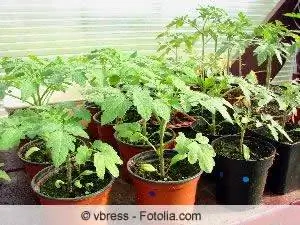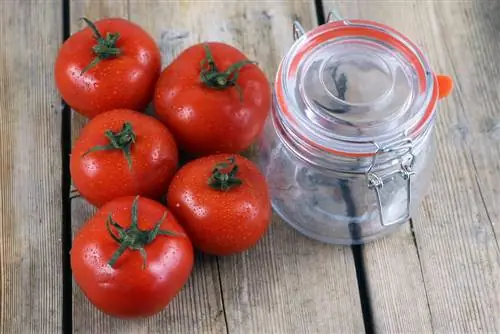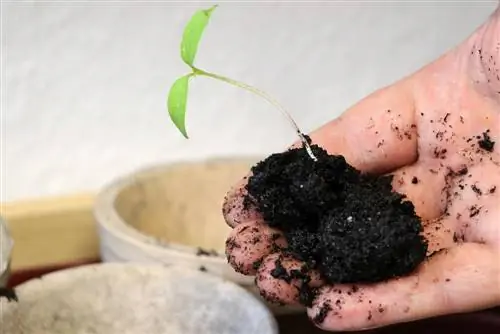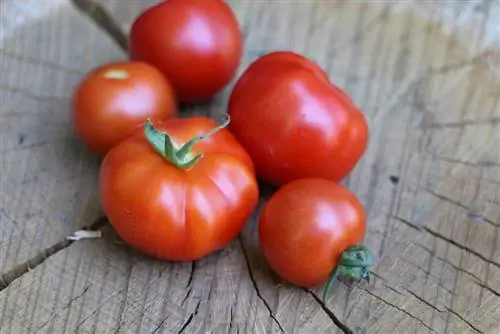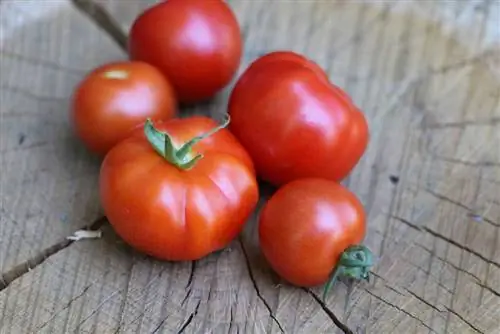- Author admin [email protected].
- Public 2023-12-17 03:39.
- Last modified 2025-01-24 12:45.
Many hobby gardeners would like to grow their own tomatoes. Because they don't taste as watered down as the tomatoes from some supermarkets. However, when choosing tomato varieties, it is important to remember that the taste of a tomato increases with the sugar content. However, a high sugar content is only achieved in a warm, sunny location. There are so many different types of tomatoes that some hobby gardeners find it difficult to choose. We have put together some tasty varieties for you and sorted them by color and size.
Red tomato varieties
Small fruits
The tomato varieties with small, red fruits are very popular because they thrive on south-facing walls even without additional protection.
Dark red cherry tomato
- high-yielding cocktail tomatoes
- very juicy
- very fruity taste
- Growth height up to 1.8 m
- Weight per fruit 10 to 20 g
- for garnishing, snacking in salads or eating raw
Sugar Grape
- very rich wearing
- very juicy, aromatic and sweet
- Growth height up to 2 m
- Weight per fruit 15 to 25 g
- for garnish or eating raw
Medium-sized fruits
Alicante
- early ripening variety
- round shape
- very aromatic taste
- Growth height up to 2 m
- Weight per fruit 50 to 100 g
- for soups, purees or salads
Red Cossack
- very profitable
- Growth height up to 1.8 m
- round shape
- juicy, fruity, aromatic
- for cooking or salads
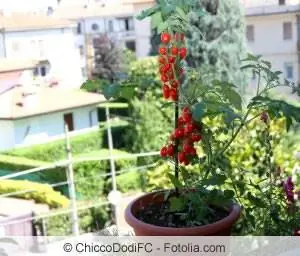
Big fruits
Andean Horn (Andine Cornue)
- old beefsteak tomato variety with firm flesh
- early ripening farm variety
- Appearance similar to a large chili pepper
- Growth height up to 2m
- very al dente and aromatic, sweet and melty
- for filling, garnish or eating raw
Best of Bonn
- ribbed, round shape
- no hard shell
- very aromatic
- Weight per fruit 70 to 120 g
- for antipasti, sauces, salads or for pickling
Cooking and Roma tomatoes
Rio Grande
- Italian cooking tomato
- oval shape
- Growth height up to 1.5 m
- high late blight tolerance
- finely bitter taste
- Weight per fruit 60 to 90 g
- for ketchup, soups, sauces
Roma Nano
- firm pulp
- bottle-like shape
- few cores
- Growth height 1.4 m
- fine aroma
Bellstar
- oval, plum-like shape
- meaty fruits
- Growth height 1.5 m
- also suitable for pots and buckets
- typical, delicately bitter Roma tomato aroma
- for ketchup, sauces and soups
Pink tomato varieties
Medium-sized fruits
Red Zora
- strongly growing and very productive
- elongated shape
- Space for climbing is ideal for them
- Growth height up to over 3 m
- Weight per fruit 70 to 110 g
- for pickling, for puree, salads and garnish
Rutgers
- pink to pink
- round with slight furrows
- Growth height 1.50 to 2.50 m
- Weight per fruit 70 to 95 g
- very juicy and aromatic sweet
- for pasta sauces, for pickling or in salads
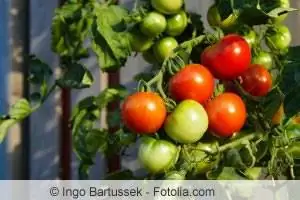
Big fruits
Marianna's Peace
- originally from the Bohemian Forest
- potato leafy beefsteak tomato
- flat-round, furrowed fruits
- Growth height 1.50 to 2.50 m
- Weight per fruit 170 to 350 g (sometimes 500 g)
- sweet and fruity
- for chutney, puree, sauces and salads
Silesian raspberry
- Eastern European variety
- flat shape with grooves
- Growth height up to 2 m
- soft, raspberry-colored flesh
- Weight per fruit 150 to 250 g
- juicy and aromatic
- for salads, sauces, pickling and cooking
Yellow tomato varieties
Very small fruits
Reinhard's golden cherry
- German variety
- round shape
- Growth height up to 2.2 m
- Size of the fruits 2 to 3 cm
- Weight per fruit 2 to 6 g
- very aromatic
- for snacking or garnishing
Lemon Grape
- slightly ribbed, light yellow fruits
- Growth height up to 2.5 m
- Weight per fruit 15 to 30 g
- sweet aroma with a subtle sour note
Small to medium sized fruits
Golden Queen
- steel tomatoes bred between 1870 and 1880
- do not confuse with Golden Queen!
- round shape
- medium early variety
- yellowish with a slight red color at the flower pole
- Growth height 1, 80 m
- Weight per fruit 40 to 80 g
Schönhagener Frühe
- early ripening variety
- Growth height up to 3 m
- Weight per fruit 20 to 35 g
- juicy and sweet
Big fruits
Limmony
- Beef tomato with bright yellow fruits
- Growth height up to 2.20 m
- Weight per fruit 15 to 250 g
- very aromatic
- suitable for cooking
Yellow pepper tomato
- needs a lot of light
- shaped like a pepper
- Growth height up to 2 m
- Weight per fruit 70 to 140 g
- very juicy and aromatic
Tomato varieties in orange
Big fruits
Orange Queen
- round shape
- Growth height up to 1.8 m
- Weight per fruit 120 to 200 g
- very nice aroma, sweet with very little acid
- perfect for salsa
Siberian Golden Pear
- bag-shaped shape
- Growth height 1.9 m to 2 m
- Weight per fruit 100 to 160 g
- especially for antipasti
Multi-colored stripes
Tigerella
- very resilient tomato
- medium-sized, red-yellow striped fruits
- Growth height 1.8 m to 2.50 m
- Weight per fruit 80 to 100 g
- somewhat hard shell
- sparkling aroma
Beauty Queen
- rather delicate growth
- multicolored, medium-sized fruits with pronounced stripes
- Growth height up to 1.8 m
- Weight per fruit 70 to 110 g
- spicy-sweet aroma with balanced acidity
Basics for delicious tomatoes
In addition to a sunny, warm location, tomato plants need enough space so that open plant growth is possible. The more sun the tomato plants receive, the more aromatic their fruits will be. For example, regular thinning out of the side shoots creates space, which also makes the plant easier. In addition, nutrients are channeled into the selected fruit bases, from which richer tomatoes can then ripen. The first harvest from a tomato plant always has the best aroma because it is very well supplied with nutrients. You should keep pests at bay with beneficial insects or nettle-horsetail manure, which also has a good fertilizer effect.
Tip:
Always let the fruit fully ripen. However, this is no longer so easy to achieve in autumn, so half-ripe or green tomatoes are removed to ripen. These differ significantly in aroma from the first harvest from the same plant.
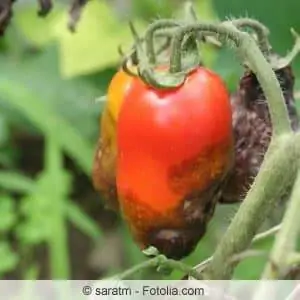
Fertilize at the right time
Tomatoes should receive a lot of potassium and not too much nitrogen. If the fertilizer is incorporated into the soil during planting, it has a very positive effect on the taste. Organic fertilizer should have already been converted by the time the fruit ripens. Because if the soil is fertile and very rich in minerals, the tomatoes taste much better than on unfertilized or only moderately fertilized soil that contains more sand than humus. Mature compost is therefore highly recommended as fertilizer. But you can also fertilize with commercial tomato fertilizer.
Storing tomatoes
Tomatoes stored at temperatures of 18 to 25 °C show the best taste. If you put them in the fridge, they lose a lot of their flavor. Unripe tomatoes cannot ripen properly in the refrigerator. It is therefore better to store the unripe autumn harvest in a warm room so that a good aroma can develop.
Preventing tomato diseases
If you want to harvest fruits with great aroma, it is also important that you keep diseases away from the plants, such as:
Blight and brown rot
This fungal disease usually attacks tomato plants when it rains. Since the fungal pathogens are bound to water, they can easily penetrate the plant from the soil. The disease manifests itself in dried and wilted leaves as well as hard and brown fruits.
Prevention: A tomato tent or rain cover protects the plant from infection with the pathogen.
Tomato mosaic virus (Tobacco mosaic virus)
You can recognize the infestation by mosaic-like spots and deformities on the leaves, which can also affect the fruits. Once the plants are infected, their growth lags behind.
Prevention: When planting, only use strong young plants and pay attention to crop rotation. For tomatoes, this means that they cannot be planted on the same bed for 3 to 4 years. Create optimal growing conditions for the plants and water regularly, but not too much.
Conclusion
Tasty tomatoes come in many different sizes, shapes and colors. A sunny, warm, protected location and good fertilization are important for a good aroma. It is also important when you harvest the tomatoes. They should not be taken half ripe, but not overripe either. Of course, in autumn it is usually no longer possible to pick up the last tomatoes when they are ripe. However, you can ripen half-ripe or green tomatoes in a warm room.

